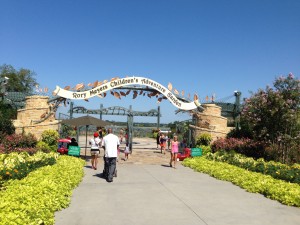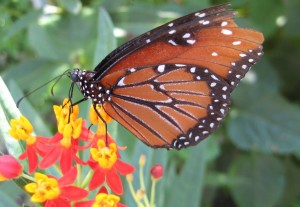Calling it a children’s garden is misleading. A visit to the Rory Meyers Children’s Garden at the Dallas Arboretum is like a visit to an outdoor, natural science museum. And best of all, you don’t need to a kid to have fun here!
 Covering eight acres, the Rory Meyers Children’s Garden is so chocked full of activities that we spent hours exploring its outdoor (and indoor) exhibits.
Covering eight acres, the Rory Meyers Children’s Garden is so chocked full of activities that we spent hours exploring its outdoor (and indoor) exhibits.
Pure Energy. Located at the bottom of the garden, Pure Energy is a favorite spot during hot summer days. Explore renewable energy from solar, wind, and water on a stage surrounded by a small pond. Little kids enjoy getting wet with the hands-on water exhibit. Adults and older kids can experience a tornado and learn more about wind turbines.
Texas Wetlands. While we didn’t see much in the way of living wildlife (aside from birds and squirrels), bronze animal statues populate the area around the wetlands. And we learned all about the vital role different plants play in filtering and cleaning wetlands. Who knew cattails purify water better than my faucet filter?
First Adventure. Located just at the Rory Meyers garden entrance, the First Adventure area is what you would expect from a children’s garden. It’s a play area for the littlest garden explorers. Kids crawl on giant whimsical ants, play with exhibits set at toddler height, and plant table-top vegetable gardens.
OmniGlobe. One of only five in Texas, my family’s favorite exhibit was the OmniGlobe located inside the Exploration Center. This unique system projects simulations onto a spherical (think Earth) display. We watched continental formation over hundred millions of years, and simulations of tsunamis and hurricanes. The OmniGlobe displays astronomical phenomenon, too. My teenager thought this exhibit alone was worth the visit.
Secret Garden. Children (and even adults) looking for an adventure quest will enjoy this garden maze. While there were no dragons, we used our imagination as we wove our way towards the castle at the center of the maze.
When you go. Open daily from 9 a.m. to 5 p.m., the Dallas Arboretum is at 8525 Garland Road. Admission is $15 for adults and $10 for children. Admission to the Rory Meyers Children’s Garden is an additional $3. Situated just outside the children’s garden, the Garden Cafe by Two Sisters sells a wide variety of pre-packaged snacks and sandwiches, along with drinks and ice cream bars.
Visitor Tip: A Dallas Arboretum membership can pay for itself after just two visits. The family membership is $125. Sounds expensive, but members can bring a total of six people with them each time they visit the arboretum (and the guests do not have to be family).




